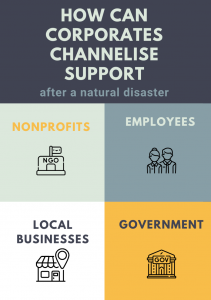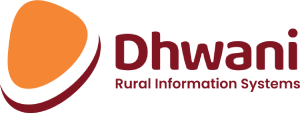With extreme weather conditions on the rise in India, natural disasters have become a matter of immediate concern for communities, government, civil society organisations and corporates. Natural disasters cause loss of life, and property, and knock communities back on developmental goals.
Typically, disaster management includes five steps: prevention of disaster, mitigation to reduce losses, preparedness for emergencies, response/relief after a disaster, and recovery to build lives back. Here, we will focus on response or relief which involves providing shelter, food, clothes, medicines, etc to affected communities in the aftermath of a natural disaster. Based on our work with corporates, here are some ways in which businesses can respond to disasters.
How can corporates contribute?

Funds: The most obvious support corporates can extend is through funding relief work on the ground. The following examples illustrate how funding can be provided:
- These funds can be sent to local NGOs undertaking relief works in the area to cover the cost of relief items, cost of transportation, personnel cost etc.
- Moreover, corporates can also support the Relief Funds of Chief Ministers or Prime Ministers
-
Raised through programmes like matching donations against employees’ contributions on employee volunteering platforms like Benevity. Companies can list nonprofits here to which employees can directly donate.
-
Raised through matching donations to local charities. Some of the platforms that can be used are Give, Donatekart, and Milaap for fundraising.
In-kind Donations: Corporates can directly send relief items to affected communities. A few ways in which in-kind donations can be sent are mentioned below:
- Donating items that a corporate produces or trades in like food, blankets, shelter items (tarpaulin, ground sheet), hygiene items (soap, toothpaste) etc is a strategic move. These items can be quickly kitted and donations can be aligned from factories or storage units to affected areas. Here’s an example of Pfizer donating medicines as their disaster response.
- A collection drive can also be organised with the employees for in-kind donations which can be donated to nonprofits like Goonj.
For corporates that have disaster relief as a mandate in their CSR policies, and treat is a major focus, pre-positioning non-food relief kits may be useful and allow swift deployment in affected communities immediately after a disaster.
After a rapid needs assessment, corporates should compile a donation kit that is relevant to the communities – for example, milk may not be relevant because of its short shelf life. However, milk powder can be included in the kit. Items with long shelf life or no expiration date, that are also culturally relevant, and of urgent requirement should be put together for in-kind donations.
Service Provision: Disasters may sometimes involve the breakdown of critical services, like transportation, telecommunications, etc. There may be a need to supplement government efforts for these services even without a breakdown situation. Corporates that provide these services as their regular trade and business can leverage their strength and can come forward with this offering.
For example, a corporate with transportation expertise can offer movement services to nonprofits or the government for the movement of relief items. Amazon’s work in Assam Flood Relief in May 2022 is an example of positioning a corporate’s core strength as an offering during disasters.
Employee Volunteering: Corporates can engage employees in their disaster response efforts. Along with making donations, employees can support relief efforts in other ways:
- undertaking collection drives for relief items
- supporting corporates in assembling relief kits
- volunteering for need assessment or damage assessment post-disaster.
Suggest active local charities and nonprofits to their corporates for funding, donation support, or employee volunteering
SAP’s response to the Kerala floods in 2018 and Tata’s disaster relief framework involving volunteering on the field are some examples of engaging employees for disaster relief. This can be especially helpful in the corporate’s area of operation as the employees engage in helping their communities, and can even help the corporate gain goodwill of the communities.
What are some partnership models to help channelise disaster response?
 Partner with nonprofits: Corporates can activate their nonprofit partner network and look for partners a
Partner with nonprofits: Corporates can activate their nonprofit partner network and look for partners a
- Corporates can either engage with small local organisations or with bigger/aggregator nonprofits that in turn have a network of local nonprofits (like GIVE, Donatekart, United Way, etc.). Corporations can decide based on their bandwidth to engage with nonprofits one-on-one and on the scale of their response.
Actively working on disaster response. Typically, in the wake of a disaster, nonprofits – big and small – engage in rapid response efforts to help deliver aid to communities. Nonprofits can support corporates in various ways – help with needs assessment, relief deployment, procurement of supplies, organising volunteers, connecting with local nonprofits, etc.
- For a scaled-up response going the nonprofit aggregator route is better as it gives access to a larger nonprofit network without having to coordinate with each NGO directly. This allows the corporate to pool in the expertise of different nonprofits – while one can put together kits, another nonprofit can bring in their field presence and support with beneficiary identification and kit distribution.
- For a response focused in a small area ranging up to a district where a few communities require support, it makes more sense to directly work with a local nonprofit. Corporations can also reach out to their employees for suggestions on local charities and nonprofits. Often the employees will suggest active nonprofits that are supporting their communities effectively.

Partner with other corporates: Corporates can come together with their unique competencies to support communities after disasters. For example, an FMCG company can donate their non-perishable relief items and collaborate with a corporate with transportation strength to execute rapid relief delivery. It makes sense for corporates to keep a lookout for complementary efforts that other businesses may be making.
These collaborations are often led by nonprofits, where they are supporting two different corporates for one relief effort and have these corporates collaborate indirectly. Other times, corporates may come together to execute a combined response strategy.
Partner with local businesses/vendors: While local businesses/vendors may not have a mandate for a humanitarian response after disasters, they are critical for relief work. Local businesses and vendors, like Kirana shop owners, warehousing businesses, etc. can be reached for quick procurement, kitting, and storage of relief items. Corporates can partner with vendors that may be in their network, or reach out to them through their local nonprofits.
Collaborating with local businesses and vendors can be especially useful for in-kind donations response strategy. Corporates with pre-positioned relief kits may also often choose to partner with warehousing vendors instead of using their warehouses to outsource responsibilities and cut back on time costs. The local business may offer discounts on their items or services since these relief efforts are for a humanitarian cause and involve bulk procurement.
Partner with the Government: The District Disaster Management Authority is at the forefront of response efforts in the area, while other levels of the government are also activated in case of bigger disasters that affect more than one district or sometimes more than one state. Corporations can support the government’s efforts by donating funds to the Chief Minister’s relief funds which are often amplified during disasters, or the PM Relief fund, in case of national-level disasters, like COVID-19. Here is a list of states’ relief funds. Corporates can also engage with the government to provide in-kind donations or offer services like transportation, telecommunication, data collection and visualisation etc.
Typically, corporates partner with the government through nonprofits, where the corporate supports a nonprofit supporting government’s relief efforts. Also, local representatives of the corporate can engage more deeply with local government actors on the ground like the district authorities or panchayats to activate efforts like employee volunteering.
Learnings
Here are a few callouts based on some of our work with corporates responding to disasters.
- The support being sent should be based on communities’ needs and should be sent timely. Corporates can consult with nonprofits on situation analysis and needs assessment. The support should be contextual to the needs. For example, in a ration kit, the items should be typically consumed in that area – type of cooking oils, rice vs atta, and type of pulse are some of the customisations required.
- Consulting with nonprofits on the situation and needs assessment helps to send the required support at a time when communities need it the most, and not be wasteful.
- When putting together an in-kind donation response, it is better to send a kit instead of a few individual items. Also, these kits should be strategically put together based on their purpose. For example, if a corporate wants to send support to relief shelters where cooking may not be possible, sending ready-to-eat kits that include items like bread, jam, and milk powder makes more sense than sending a ration kit that has rice, pulses, etc. These kits can be supplemented with hygiene items like toothbrushes and toothpaste. Sending individual items may end up costing the same as sending kits, but may be able to solve only one of the problems that communities may be facing.
- To ensure the on-field execution is undertaken timely and effectively, corporates should partner with nonprofits after due diligence. Check to see if the nonprofit has onfield presence, and storage and distribution capabilities, understand if they are working with the local government on relief distribution, understand how they will identify beneficiaries, and see if they are aligned on reporting requirements that the corporate may require among other things.
- There may be brand risks to sending in-kind donations in case the items expire, or if the service provided by corporate is not up to standards. For example, if a corporate provides cold vans for vaccinations, however, the van malfunctions and vaccines expire – this can pose a big threat to the company’s brand. If corporates decide to extend in-kind or service-based support to communities, ensuring the quality of support is critical.
- Some items may be risky to send to communities – like water decontamination tablets, medicines, etc. Items like these may pose risk to communities in case they are consumed incorrectly. Utmost care must be taken in the distribution of these items and in ensuring these are used or consumed properly.
- Funding may be the most prudent form of support that corporates can extend. This puts, to some extent, the responsibility of the quality of support on the nonprofits and reduces brand risk.
- Keeping the reporting to the minimum for nonprofits is best in disaster situations. Try to understand that all relief has been distributed in the communities within the agreed-upon timeline. Extensive reporting is usually not possible. Also, if possible, try to get feedback from the nonprofits on the kits or services provided to see the scope for improvement.




